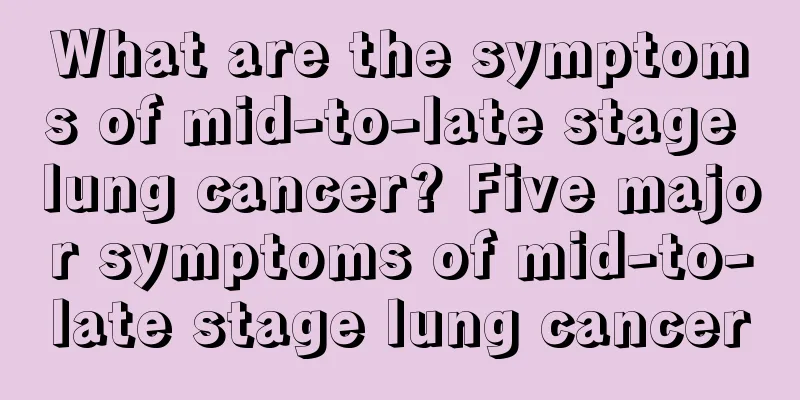What are the symptoms of mid-to-late stage lung cancer? Five major symptoms of mid-to-late stage lung cancer

|
Lung cancer is a very common type of malignant tumor and the second leading cause of death in humans. There are many causes of lung cancer in daily life. Once you have lung cancer, if you do not actively treat it, it is likely to induce diseases in other organs of the body. Let us now learn about the five symptoms of middle and late stage lung cancer. 1. The top of the upper lobe of the lung can invade and compress the organs and tissues located at the upper opening of the thorax, such as the first rib, subclavian artery and vein, brachial plexus, cervical sympathetic nerves, etc., causing severe chest pain, upper limb venous distension, edema, arm pain and upper limb movement disorders, ptosis of the upper eyelid on the same side, pupil constriction, enophthalmos, facial anhidrosis and other cervical sympathetic nerve syndromes. After lung cancer metastasizes through the blood, different symptoms will occur according to the invaded organs. 2. Hoarseness is the most common symptom. The recurrent laryngeal nerve that controls the left side of the vocal function goes down from the neck to the chest, bypasses the large blood vessels of the heart and goes back up to the larynx, thus controlling the left side of the vocal organ. Therefore, if the tumor invades the left side of the mediastinum and compresses the recurrent laryngeal nerve, hoarseness will occur, but there will be no sore throat or other symptoms of upper respiratory tract infection. 3. Invasion of the pleura can cause pleural effusion, which is often bloody. Large amounts of effusion can cause shortness of breath. In addition, invasion of the pleura and chest wall by cancer can cause persistent and severe chest pain. 4. Ultimately, almost all patients with regionally spread lung cancer experience varying degrees of shortness of breath. Normal tissue fluid produced by the lungs and myocardium is returned by the lymph nodes in the middle of the chest. If these lymph nodes are blocked by tumors, this tissue fluid will accumulate in the pericardium to form pericardial effusion or accumulate in the chest cavity to form pleural effusion. 5. On the right side of the mediastinum is the superior vena cava, which transports venous blood from the upper limbs and head and neck back to the heart. If the tumor invades the right side of the mediastinum and compresses the superior vena cava, it will initially cause the jugular vein to become swollen due to poor blood return, and eventually lead to edema of the face and neck, which needs to be diagnosed and treated in a timely manner. Understanding these symptoms of lung cancer helps us diagnose the disease. I believe that through this article, everyone has learned about lung cancer. I hope that in the future, everyone can do a good job in preventing lung cancer and try to avoid the occurrence of lung diseases. |
<<: How to avoid liver cancer? Always eat this kind of food and beware of liver cancer
Recommend
What to eat after bladder cancer surgery
What foods are good for bladder cancer after surg...
Regulation of insulin secretion
Insulin is secreted by pancreatic cells in the hu...
Does it hurt to wash your teeth? Learn about teeth cleaning
Teeth cleaning is an important way to keep teeth ...
What is severe aplastic anemia and what are its symptoms?
Severe aplastic anemia is a disease that we often...
What is the problem with scalp falling off in lumps
There can be many problems with the scalp, such a...
How to treat facial crookedness caused by tooth misalignment?
The teeth generally need to be aligned to maintai...
Swimming pool water allergy
With the arrival of summer, in addition to the va...
What is the approximate recurrence rate of colon cancer
What is the recurrence rate of colon cancer? The ...
How to treat patients with spleen deficiency
People nowadays are always busy with their work a...
Symptoms of advanced bladder cancer
If bladder cancer reaches the late stage, everyon...
If there is something in the stomach during gastroscopy, could it be stomach cancer?
Gastroscopy is the gold standard for diagnosing g...
What is the treatment for bleeding teeth
Many people may have experienced bleeding teeth. ...
Routine care for skin cancer patients
People have a fear of skin cancer. When they go t...
What are the treatments for localized endometrial cancer? There are five treatments
The preferred treatment for localized endometrial...
Why does my shoulder joint hurt when I do bench press in the gym?
In recent years, people are more and more fond of...









